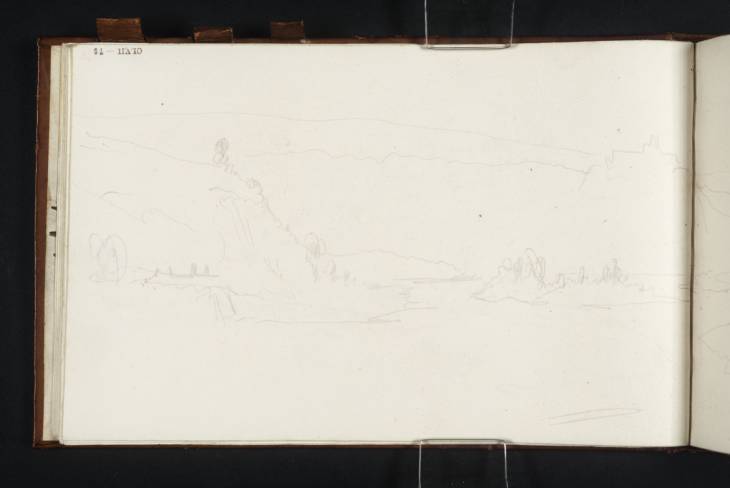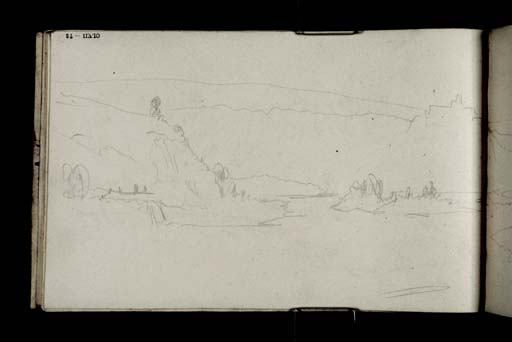Joseph Mallord William Turner Prudhoe Castle from the Tyne Valley 1817
Image 1 of 2
Joseph Mallord William Turner,
Prudhoe Castle from the Tyne Valley
1817
Joseph Mallord William Turner 1775–1851
Folio 78 Recto:
Prudhoe Castle from the Tyne Valley 1817
D12417
Turner Bequest CLVII 78
Turner Bequest CLVII 78
Pencil on white wove paper, 116 x 185 mm
Inscribed by John Ruskin in red ink ‘78’ top left, upside down
Stamped in black ‘CLVII – 78’ top left, upside down
Inscribed by John Ruskin in red ink ‘78’ top left, upside down
Stamped in black ‘CLVII – 78’ top left, upside down
Accepted by the nation as part of the Turner Bequest 1856
References
1909
A.J. Finberg, A Complete Inventory of the Drawings of the Turner Bequest, London 1909, vol.I, p.450, CLVII 78, as ‘Prudhoe Castle, Northumberland’.
1975
Andrew Wilton, Turner in the British Museum: Drawings and Watercolours, exhibition catalogue, Department of Prints and Drawings, British Museum, London 1975, p.74 under no.106.
1979
Eric Shanes, Turner’s Picturesque Views in England and Wales 1825–1838, London 1979, pp.27 under no.11, 156.
1979
Andrew Wilton, J.M.W. Turner: His Life and Work, Fribourg 1979, p.393 under no.798.
1990
Eric Shanes, Turner’s England 1810–38, London 1990, pp.73 under no.143, 284 note 120.
1998
Kim Sloan, J.M.W. Turner: Watercolours from the R.W. Lloyd Bequest in the British Museum, London 1998, p.92 under no.27.
Dating from the early twelfth century, Prudhoe Castle passed from the d’Umfraville barons of Prudhoe to the powerful Percy family (whose other Northumberland properties included Alnwick Castle) in 1398; it is now an English Heritage property. After falling into ruin it was partly restored in about 1818, not long after Turner’s visit, when a house for the castle steward was built within the walls.1
The castle appears as in perfunctory outline on the skyline towards the right as the main focus of a two-page view, which continues to the right on folio 77 verso opposite (D12416) with the wooded north bank of the River Tyne and a glimpse of the hills beyond Prudhoe. Turner’s viewpoint is the north side of the river along the Wylam to Ovingham road near Howdene Bridge, looking south-west up the Tyne to the castle, past Hagg Bank on the left and the small island in the river on the right. The far side of the valley below the castle is now industrialised and flanked by the Newcastle to Carlisle railway, but the foreground remains rural.
The double-page sketch was the main source for the watercolour Prudhoe Castle, Northumberland of about 1825 (British Museum, London),2 engraved in 1828 for Turner’s Picturesque Views in England and Wales. As various commentators have noted, the hills are further exaggerated and simplified in the watercolour as the castle merges with its setting in a blue silhouette as if it were one of the castles on the Rhine crags which he had observed on his journey along that river in 1817, just before his visit to Durham and Northumberland (see the introduction to the tour); he also introduced an extensive foreground with seated figures and a brilliant, low, Claude Lorrain-style afternoon sun above the ruin.3
Matthew Imms
February 2010
‘Prudhoe Castle’, English Heritage, accessed 10 February 2010, http://www.english-heritage.org.uk/server/show/nav.18764 ; [Sarah Yates (ed.)], Heritage Unlocked: Guide to Free [English Heritage] Sites in Yorkshire & the North East, London 2004, p.97.
How to cite
Matthew Imms, ‘Prudhoe Castle from the Tyne Valley 1817 by Joseph Mallord William Turner’, catalogue entry, February 2010, in David Blayney Brown (ed.), J.M.W. Turner: Sketchbooks, Drawings and Watercolours, Tate Research Publication, December 2012, https://www


